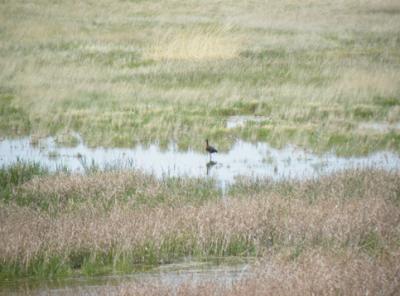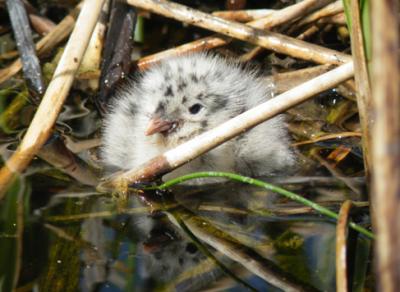Avian Oasis at Manning Lake
Tribal Wildlife Refuge
Sunrise casts golden light on Manning Lake in northeastern Montana. The hush within green bulrush and cattails fronting the lake gradually gives way to a cacophony of birdsong rising and falling, fading out and lifting again, growing louder and more diverse. A joyful heralding of the golden light is how we bird lovers would like to interpret the chorus. Science, however, upends such poetic notions about birds: the throng of songs is actually individual declarations — “Hey, this is my territory!”

Every spring thousands of hungry, tired migrating birds wing their way to Manning Lake. Here the birds loaf, claim their territories, breed, nest, and raise their young. The three-foot-deep lake is the heart of the 4,137-acre Manning Lake Tribal Wildlife Refuge tucked within a 22,000-acre wetlands and grasslands complex on the Fort Peck Indian Reservation.
“The complex is rare in the sense that it is mostly undegraded by anthropological disturbances and relatively unfragmented,” explains Jeanne Spaur, the wetlands program coordinator and wildlife biologist for the Fort Peck Tribal Office of Environmental Protection.
The primitive Refuge has no paved roads, official parking area, interpretive kiosks, or walking trails. It’s a distant drive for many birders, but it’s worth the gas and miles because the mixed habitats offer optimal birding opportunities. Prairie songbirds flutter over contiguous blocks of grasslands. Raptors dip and soar above gullies and undulating hills. Waterfowl and shorebirds congregate in the rich mosaic of wetlands and alkali flats.
An avian oasis like this one in a water-limited region is a matter of survival for migrating birds. In fact, 70 percent of migrating species use wetlands during migration. The multitude of species and sheer numbers of birds found at Manning Lake led the Sioux and Assiniboine Tribes to nominate, and Montana Audubon Society to designate, the bird-rich site as an Important Bird Area (IBA). According to Montana Audubon, an IBA provides “essential habitat to one or more species of breeding, wintering, and/or migrating birds.”

“To date we’ve officially documented 67 bird species,” Spaur says. “Our prime bird time is mid-May through mid-July.” Brimming with enthusiasm, she adds, “In the spring, the lake is full of birds. It’s a noisy place.” Spaur is confident the nascent list of species will grow, given the Refuge’s diverse habitat and expanse of it.
Many birders would be thrilled to spot these shorebirds feeding along the Manning Lake shoreline: Wilson’s Snipe, American Avocet, Willett, and Black-crowned Night-heron. They might also observe Marbled Godwit, White-faced Ibis, Wilson’s Phalarope and American Bittern — all of which Montana Audubon considers “Species of Concern.” Unfortunately, study after study shows shorebird numbers are declining dramatically.
Canada Goose, Snow Goose, Tundra Swan, Mallard, Gadwall, Northern Shoveler, Redhead, Cinnamon Teal, Blue-winged Teal, Common Goldeneye, and Northern Pintail are the abundant waterfowl species. While Northern Pintails are plentiful at Manning Lake, population numbers for these ducks plummeted an alarming 71 percent in the past 40 years, even as populations of other duck species that nest in the same habitat have increased. Not surprisingly, the pintail is a Species of Concern.
Land-loving Franklin’s Gulls, which can be seen wheeling above Manning Lake, make their home on the northern Great Plains instead of seacoasts. Its Species of Concern status is directed more toward limited breeding sites than actual declines in population.

“The Refuge is one of only five places in Montana where Franklin’s Gulls have breeding colonies,” says Steve Hoffman, Director of Montana Audubon. “There are approximately 5,000 breeding pairs of Franklin’s Gulls at Manning Lake, so the Refuge is very significant to that species.”
Vast tracts of unfragmented grasslands dotted with marshes and sagebrush are rare finds for today’s prairie-loving birds. Our American prairie is among the most altered ecosystems in the world. Cultivation, overgrazing, and invasion by exotic plant species, have sent grassland bird populations tumbling, as much as 40 percent in 40 years. Yet, at the Refuge, birders have a good chance of adding these grasslands Species of Concern to their life list: Chestnut-collared Longspur, McCowen’s Longspur, Lark Bunting, Baird’s Sparrow, Long-Billed Curlew, Nelson’s sharp-tailed sparrow, and Grasshopper Sparrow.
The delicate sparrow-like Sprague’s Pipit, which spends most of its life hiding in the grass, is also found here. A good time to observe this Species of Concern is spring, when the males territorialize. He displays by flying from the ground into the wind, ascending high in the air, singing and gliding and often pushed backward by the wind; then he repeats the display, and finally plummets straight down, landing in the grass. He performs the longest-known flight display of any bird species, and of North America’s avian species, his is one of the least studied.
The clear, liquid, melodious song of our state bird, the Western Meadowlark, is synonymous with sunrise on the prairie. His leisurely warbling carries across the plain, to the adjoining wetlands where shorebirds wrest midges, snails, and fairy shrimp from underwater plants. At Manning Lake, a din of territorial voices rises and grows louder as dawn’s warm radiant light falls upon the bulrush and cattail leaves.

Red Rock Lakes -- National Wildlife Refuge
Geothermal activity keeps its lakes ice-free, allowing swans to inhabit the 45,000-acre Refuge year-round. Its elevation rises from wetlands at 6,609 feet to alpine habitat at 9,855 feet. When compared to other migrating bird hotspots, spring migration here is lackluster because birds pass it by when they see the lingering snowpack. The tumult of migrating birds is much more dramatic in the fall.
Habitats: Sagebrush grasslands, wetlands, aspen and coniferous forest, alpine.
Best Birding Months: Mid-August to mid-November.
Highlight: Trumpeter Swan.
Location: 45 miles west of West Yellowstone, off of U.S. 87.
Phone: 406-276-3536.
Web site: www.fws.gov/redrocks












Leave a Comment Here